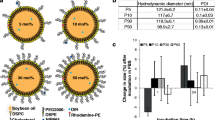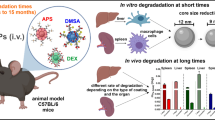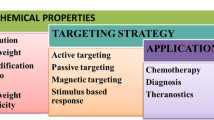Abstract
Purpose. The aim of this study was to investigate the different pharmacokinetic behavior of surface-modified poly(methylmethacrylate) (PMMA) nanoparticles.
Methods. The particles were 14C-labeled and coated with polysorbate 80, poloxamer 407, and poloxamine 908. Plain particles served as control particles. In vivo studies were performed in three tumor models differing in growth, localization, and origin. Particle suspensions were administered via the tail vein, and at given time animals were killed and organs were dissected for determination of PMMA concentration.
Results. For the PMMA nanoparticles coated with poloxamer 407 or poloxamine 908, high and long-lasting concentrations were observed in the melanoma and at a lower level in the breast cancer model. In an intracerebrally growing glioma xenograft, the lowest concentrations that did not differ between the tumor-loaded and tumor-free hemispheres were measured. Organ distribution of the four investigated batches differed significantly. For instance, poloxamer 407- and poloxamine 908-coated particles circulated over a longer period of time in the blood, leading additionally to a higher tumor accumulation. In contrast, plain and polysorbate 80-coated particles accumulated mainly in the liver. The strong expression of vascular endothelial growth factor and Flk-1 in the melanoma correlated with high concentrations of PMMA in this tumor.
Conclusion. The degree of accumulation of PMMA nanoparticles in tumors depended on the particle surface properties and the specific growth differences of tumors.
Similar content being viewed by others
REFERENCES
Y. Matsumura and H. Maeda. A new concept for macromolecular therapeutics in cancer chemotherapy: mechanism of tumoritropic accumulation of proteins and the antitumor agent SMANCS. Cancer Res. 6:6387-6392 (1986).
H. Maeda and Y. Matsumura. Tumoritropic and lymphotropic principles of macromolecular drugs. CRC Crit. Rev. Ther. Drug Carrier Syst. 6:193-210 (1989).
L. W. Seymour. Passive tumour targeting of soluble macromolecules and drug conjugates. CRC Crit. Rev. Ther. Drug Carrier Syst. 9:135-187 (1992).
R. Duncan, S. Dimitijevic, and E. G. Evagorou. The role of polymer conjugates in the diagnosis and treatment of cancer. S.T.P. Pharma Sci. 6:237-263 (1996).
R. K. Jain. Delivery of molecular and cellular medicine to solid tumors. Microcirculation 4:1-23 (1997).
P. Beck, J. Kreuter, R. Reszka, and I. Fichtner. Influence of polybutylcyanoacrylate nanoparticles and liposomes on the efficacy and toxicity of the anticancer drug mitoxantrone in murine tumor models. J. Microencapsul. 10:101-114 (1993).
R. Reszka, P. Beck, I. Fichtner, M. Hentschel, J. Richter, and J. Kreuter. Body distribution of free, liposomal and nanoparticle-associated mitoxantrone in B16-Melanoma-bearing mice. J. Pharmacol. Exp. Ther. 280:232-237 (1997).
S. D. Tröster, K. H. Wallis, R. H. Müller, and J. Kreuter. Correlation of the surface hydrophobicity of 14C-poly(methyl methacrylate) nanoparticles to their body distribution. J. Control. Release 20:247-260 (1992).
S. D. Tröster and J. Kreuter. Influence of the surface properties of low contact angle surfactants on the body distribution of 14C-poly(methyl methacrylate) nanoparticles. J. Microencapsulation 9:19-28 (1992).
U. Schröder and B. A. Sabel. Nanoparticles, a drug carrier system to pass the blood-brain barrier, permit central analgesic effects of i.v. dalargin injections. Brain Res. 710:121-124 (1996).
J. Kreuter, R. N. Alyautdin, D. A. Kharkevich, and A. A. Ivanov. Passage of peptides through the blood-brain barrier with colloidal polymer particles (nanoparticles). Brain Res. 674:171-174 (1995).
R. N. Alyautdin, D. Gothier, V. E. Petrov, D. A. Kharkevich, and J. Kreuter. Analgesic activity of the hexapeptide dalargin adsorbed on the surface of polysorbate 80-coated poly(butylcyanoacrylate) nanoparticles. Eur. J. Pharm. Biopharm. 41:44-48 (1995).
R. N. Alyautdin, V. E. Petrov, K. Langer, A. Berthold, D. A. Kharkevich, and J. Kreuter. Delivery of loperamid across the blood-brain barrier with polysorbate 80-coated poly-butyl-cyanoacrylate nanoparticles. J. Pharm. Res. 14:325-328 (1997).
J. Kreuter, U. Täuber, and V. Illi. Distribution and elimination of poly(methyl-2-14C-methacrylate) nanoparticle radioactivity after injection in rats and mice. J. Pharm. Sci. 68:1443-1447 (1979).
F. Brasseur, P. Couvreur, B. Kante, L. Deckers-Passau, M. Roland, C. Deckers, and P. Speiser. Actinomycin D adsorbed on polymethylmethacrylate nanoparticles: an increased efficiency against an experimental tumor. Eur. J. Cancer 16:1441-1445 (1980).
P. Couvreur, L. Grislain, and V. Lenaerts. Biodegradable polymeric nanoparticles as a drug carrier for antitumor agents. In P. Guiot and P. Couvreur (eds.), Polymeric Nanoparticles and Microspheres, CRC Press, Boca Raton, 1986.
D. Sharma, T. Chelvi, J. Kaur, K. Chakravorty, T. De, A. Maitra, and R. Ralham. Novel Taxol® formulation: polyvinylpyrolidone nanoparticle-encapsulated Taxol® for drug delivery in cancer therapy. Oncol. Res. 8:281-286 (1996).
E. M. Gipps, R. Arshady, J. Kreuter, P. Groscurth, and P. P. Speiser. Distribution of polyhexylcyanoacrylate nanoparticles in nude mice bearing human osteosarcoma. J. Pharm. Sci. 75:256-258 (1986).
B. Endrich, H. S. Reinhold, J. F. Gross, and M. Intaglietta. Tissue perfusion inhomogeneity during early tumor growth in rats. J. Natl. Cancer Inst. 62:387-395 (1979).
J. Kreuter. Drug targeting with nanoparticles. Eur. J. Drug Metab. Pharmacokinet. 3:253-256 (1994).
S. E. Dunn, A. G. A. Coombes, M. C. Garnett, S. S. Davis, M. C. Davies, and L. Illum. In vitro cell interaction and in vivo biodistribution of poly (lactide-co-glycolide) nanospheres surface modified by poloxamer and poloxamine copolymers. J. Control. Release 44:65-76 (1997).
J. E. O'Mullane, P. Artursson, and E. Tomlinson. Biopharmaceutics of microparticle drug carriers. Ann. NY Acad. Sci. 507:100-140 (1987).
Author information
Authors and Affiliations
Rights and permissions
About this article
Cite this article
Lode, J., Fichtner, I., Kreuter, J. et al. Influence of Surface-Modifying Surfactants on the Pharmacokinetic Behavior of 14C-Poly (Methylmethacrylate) Nanoparticles in Experimental Tumor Models. Pharm Res 18, 1613–1619 (2001). https://doi.org/10.1023/A:1013094801351
Issue Date:
DOI: https://doi.org/10.1023/A:1013094801351




